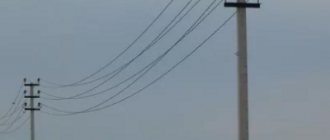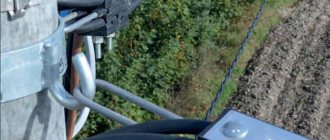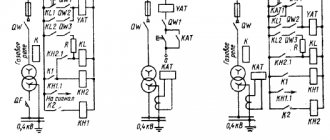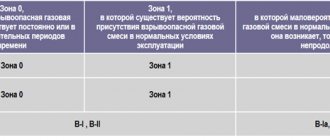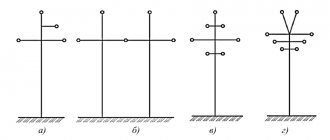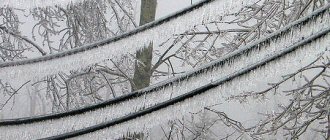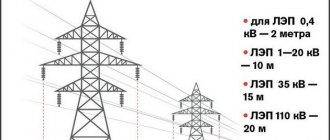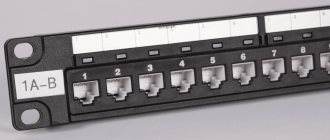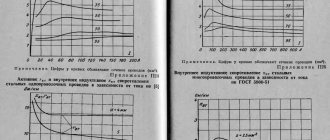Power lines for modern people are a necessity, without which it is almost impossible to function.
Some people are so accustomed to them that they no longer notice and do not pay attention to the numerous poles, but meanwhile they perform a very important task and distribute electricity over long distances.
Like any equipment, power lines are also susceptible to the influence of time and can sag, which may be due to the destruction of the insulator, weakening of the bandage, or a foreign object caught on the lines (most often tree branches or birds) is to blame.
In addition, after a long period of use, the wires can sag, so sooner or later the moment comes when you have to seriously think about how to tighten the wire.
The same question, how to tighten it if the cable is sagging, is asked by the owners of newly built houses who want to install electricity on their site.
Rolling out and lifting wires
To roll out the wires, mounting rollers are hung on the supports (photo 1). The overhead line wire is hung before rolling out.
1 way of rolling
The drum is placed on special trestles or jacks. It can rotate freely on them. The end of the cable is tied to a car or tractor through a mounting roller. The car moves along the track, and the wire rolls out along the track.
2 way of rolling
The drum is placed on jacks on the car and the car with the drum moves along the track. This method minimizes damage to the wire, but is of limited use, for example for U-shaped supports.
Tension of overhead power line wires
Wire tensioning begins after all preparatory work has been completed, the overhead line supports have been installed and aligned, the route has been cleared of obstacles, and protective devices have been installed at the intersections of overhead lines with other utilities. Before starting work, they inspect the line route, check the position of the supports, eliminate all deficiencies, and sign a certificate of readiness of the construction part of the overhead line for electrical installation.
Wire tension is carried out using the following methods:
- Using mobile sheeting machines. In this case, the wire is fixed to a support at the beginning of the section, and the machine with the drum moves along the route. The use of this method limits the presence of obstacles along the line that prevent the passage of equipment.
- Using fixed devices. A stationary device with a drum is installed at the beginning of the section, the end of the wire is fixed to a machine that moves along the overhead line route. When rolling using this method, the wires are damaged upon contact with the surface. Before lifting onto insulators, they must be inspected and repaired.
- Rolling under tension on supports. Rolling out of wires is carried out using a tensioning and braking machine, which are installed at the ends of sections of overhead lines. This method of tensioning eliminates damage to the wires; rolling is done on mounting rollers installed directly on the insulators or cross-arms of the supports.
The method of tensioning overhead line wires is chosen based on technical and economic feasibility. Rolling out wires on supports under tension eliminates contact of the conductor with the ground. This method is suitable for installing lines with SIP and bare wires. The technology for installing overhead lines with rolling out wires directly on supports includes the following steps:
- Installation and securing of the traction and braking machine. The traction and braking machines are installed at the beginning and end of the overhead line section at a certain distance from the outer support, so that the bending angle of the drives during tension does not exceed the design value.
- Lifting and rolling out the support cable. The leader cable is rolled out by drawing using a tractor or car, after which it is laid on mounting rollers and lifted onto the overhead line supports. Mounting rollers are fixed to insulators or cross-arms of overhead line supports.
- Installation of the protective stocking, connecting the wire to the leader cable through a swivel. Next, put a protective stocking on the wire and connect it to the auxiliary cable through a special swivel. This device prevents the wire from twisting when rolling out.
- Directly rolling the wire onto the rollers. At this stage, the overhead line wire is pulled along the mounting rollers on the insulators or traverses of the supports. The tension of the wire is controlled using sighting strips installed on the supports. The inspected areas are fixed with anchor clamps.
- Transfer of overhead line wires to insulators. At this stage, the wires are fixed to insulators, the conductor is freed from the protective stocking, the mounting rollers are dismantled, and spacers are installed on the split wires.
Laying wires along supports reduces power losses when corona discharges occur and eliminates the need to repair wires at the installation stage. The method is suitable for installing lines with a voltage of 220-750 kW, as well as for medium voltage overhead lines. The greatest technical and economic indicators from the use of this method are achieved with a complex overhead line route and a large number of wires.
Securing bare overhead line wires to an anchor support
On the anchor support, overhead lines up to 1000 Volts, insulators are installed to secure the wire. The wire on the overhead line anchor supports is wrapped around the insulator and secured, as in Fig. 2.a.
On an anchor support, overhead lines over 1000 Volts, the wire is also wrapped around the insulator and secured with a bolted die, as in Fig. 2.c.
In Figure 2.c you see how the wires are attached to the supports of the anchor spans, with insulators in the form of garlands.
The overhead line wire loops (short branches) are connected by thermite welding or bolted connections.
Sagging standards
Let's consider the standards of the PUE chapters 2.4 and 2.5 in relation to the sagging of high voltage overhead lines.
Near roads
Horizontal distance
When crossing an overhead line
Populated area
Unpopulated area
As can be seen from the tables, the distance from the ground to the power line, as well as between wires and other objects, depends on the voltage value. For 380 volt networks, sag standards according to Chapter 2.4 of the PUE are as follows:
- Above the pedestrian area the height is not lower than 3.5 meters, and above the roadway this distance should be at a height of not lower than five meters; the input branch can be made at a height of 2.5 meters for the SIP wire.
- For lines with non-insulated conductors, the height is not less than three and a half meters above the pedestrian area, and not less than 6 meters above the roadway, a branch can be made at least 2.75 meters.
- When passing SIP near buildings, the distance from the cable to the balcony is at least one meter and at least twenty centimeters from the wire to the blank wall.
- In the case of uninsulated conductors, the distance from windows, terraces and balconies is at least one and a half meters and at least one meter along a blank wall.
- It is strictly prohibited to place overhead lines with uninsulated conductors above buildings for safety reasons.
Norms for wire sag from pole to house
Securing overhead line wires to an intermediate support
Figure 3 shows the fastening of wires without insulation on intermediate supports. Here, two types of connections are knitted (Fig. 3, a) and a supporting clamp (Fig. 3, b).
Instead of results
Let me draw your attention to the fact that the article examined the tension of the wires of an overhead power line performed with bare wires. Such an overhead line is designated, in contrast to a power transmission line with insulated SIP wires, which is designated VLI. Linear fittings of VL differ from similar fittings of VLI.
©Elesant.ru
Other articles in the section “Overhead power lines”
- Types of power transmission line supports by material
- Types of supports by purpose
- Overhead power lines with SIP wires
- Wooden supports for overhead power lines
- Reinforced concrete power transmission line supports
- Reinforced concrete power transmission line supports
- Power line support structures
- Tension of overhead power line wires
- SIP installation mistakes that should not be made
- Preparatory work for installation of overhead power lines
Stretching and securing wires
After completing the work of rolling out, connecting and repairing the overhead line section limited by anchor or corner supports, the wires and cable are lifted and tensioned. The direction of tension must coincide with the direction of the route. If this condition is difficult to fulfill due to the terrain, then tensioning is done through additional outlet rollers.
Tensioning of wires and cables is usually done with a tractor. The required tension value is controlled by the size of the sag of the wire or cable (Fig. 4-12). The wire sag is installed by direct sighting. To do this, sighting slats are attached to adjacent supports in such a way that the marks on these slats corresponding to the size of the sag boom are on the same horizontal line.
When sighting, you need to climb onto one of the supports and, using binoculars, determine the moment when tensioning the wire should be stopped. If the wire tension is adjusted correctly, then the lowest point of sag is on the straight line connecting both sighting points. When adjusting the tension, the wire is adjusted to the line of sight not from below, but from above. The command to stop tensioning is given at the moment when the wire is overtightened by 0.3-0.5 m. After the wire has been in this position for 3-5 minutes, it is lowered to the line of sight.
The overhead line design is accompanied by the installation boom curves for the sag of the wires, as well as a list of spans in accordance with which the wires are sighted.
After the sag has been adjusted, the wires are attached to the insulators, first on anchors and then on intermediate supports. The amount of sag after securing the wire to the anchor supports should not differ from the design by more than ± 5%, and the distance of the wires and cables relative to each other should not differ by more than 10% from the design distances between them.
Wires are secured to anchor and corner supports using tension clamps. Lightning protection cables are mounted on supports as shown in Fig. 4-15. Wires and lightning protection cables on intermediate supports, as a rule, lie in unrolling rollers. Therefore, after tensioning on the intermediate supports, it is necessary to transfer them to the supporting clamps.
Safety precautions
In addition to the general safety rules when installing supports and tensioning with a cut, guy ropes are secured using anchors fixed in the ground. Guy ropes cannot be attached to the supports of an installed or existing overhead power line. After installation and alignment of the supports, work does not stop until the pit is completely backfilled. In cities and towns, during the installation of overhead lines, signals and guard posts are installed to warn that pedestrians and vehicles are not allowed to pass in spans while the wires are being hung.
When working on a corner support, be on the side of the support opposite the inside corner formed by the wires. When installing overhead lines, individual mounted sections 3-5 km long are short-circuited and grounded. During a thunderstorm, work on the installation of overhead lines is stopped and people are removed to a safe distance. Mounted overhead lines and their individual sections passing near existing lines, as well as transitions crossing existing overhead lines with voltages over 1000 V, are short-circuited and grounded before they are connected to the voltage source. When working with a truck crane, it is installed at a safe distance from the edge of the pit, strong and stable pads are placed under the outriggers, and the running gear of the crane is reliably braked with a hand brake.
What cross-section of sip cable is needed to connect a private house?
- Overhead line from pole to building. Aluminum wires without insulation are used. The method is unsafe; in recent years, they have been trying not to use it.
- Input from the overhead line using SIP. Due to the reliability of the line and operational safety, this method of delivering electricity is considered a priority.
- Armored underground cable. The method is considered the safest (especially for wooden buildings), but its disadvantage is its high cost. Rarely used.
